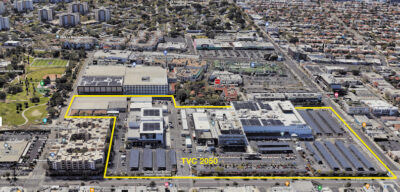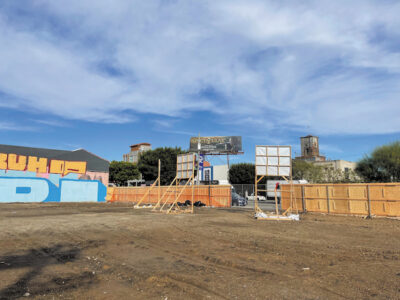Neighbors oppose ‘regional center’ and question entitlements
Not too far from the Miracle Mile, on Crescent Heights and Sunset boulevards, is an empty lot that now is for sale. It had been planned to be home to a residential-and-retail complex designed by famed architect Frank Gehry.

EXISTING television city property at the southeast corner of Beverly and Fairfax is the subject of great controversy because of a developer’s “TVC 2050” up-zoning proposal.
The backstory to this vacant piece of land is a cautionary tale that includes preservationists pitted against developers, the California Supreme Court and the mid-century modern Lytton Savings building designed by the late Los Angeles architect Kurt Meyer.
In the end, the historic bank was demolished, and the much-touted Gehry project has been abandoned.
But the entitlements and the property are now available to the highest bidder.
“Who is to say that won’t happen here?” a caller to the Chronicle asked in regard to a project closer to home, the TVC 2050 Project at the historic Television City studio on Fairfax Avenue and Beverly Boulevard.
TVC 2050 developer Hackman Capital Partners now seeks City of Los Angeles adoption of a Specific Plan for the property that it purchased from CBS Corporation in late 2018. The request includes allowing buildings with heights up to approximately 20 stories on the 25-acre site. The request would allow 1.9 million square feet of sound stage, office and other uses, plus 1.6 million square feet of additional development.

NEIGHBORS for Responsible TVC Development co-chairs Danielle Peters, left, and Shelley Wagers, right.
The developer says the project will create jobs and modernize and expand the aging TV studio, originally developed in 1952.
“We know that the TVC Project will benefit not only studio workers…but local businesses and neighbors…” Zach Sokoloff, senior vice president, Hackman Capital Partners, told us in an earlier statement.
Vague plans
Opponents of the project as currently presented argue that the plans are vague and, if approved, would allow developments twice the size of the Crypto.com Arena (the former Staples Center).
“While the developer’s rhetoric is all about building a studio… the developer is not promising to build a studio at all!” Danielle Peters, co-chair of Neighbors for Responsible TVC Development, said in a recent statement.
“The developer also seeks for the property to become a ‘Regional Center,’ allowing the same density as the Century City shopping and business district, as well as a Sign District, in a primarily residential and low-rise neighborhood,” Peters continued.
But Sokoloff, of Hackman Capital, claims “‘Regional Center’ is a technical term used by the City for sites that ‘contain a diversity of uses such as offices, retail and major entertainment facilities and supporting services,’ which ‘typically provide a significant number of jobs,’ per the City’s General Plan Framework Element. For example, The Academy Museum property, located a few blocks away, is designated as a ‘Regional Center,’” he said.
[In actuality, the Miracle Mile, with its two long-planned subway stations, has been designated a “Regional Center” since 1972, more than three decades prior to the Academy leasing and moving its new Museum onto the remodeled May Co. department store site. – Ed.]
Local community groups opposing the current version of the proposed TVC 2050 project are gaining members. Some 50 people attended the Neighbors for Responsible TVC Development’s second meeting held recently at the Gilmore Adobe at the Original Farmers Market, adjoining the proposed development.
“The last thing our neighborhood needs is this monster 20-story project towering over our neighborhood, bringing more traffic, more pollution and much higher rents,” said the group’s co-chair Shelley Wagers. Both Wagers and Peters are longtime Beverly Grove residents.

HOTEL AND APARTMENTS were approved at 639 S. La Brea, and existing buildings were demolished, but construction is on hold, with the land available for lease.
Another community-based group that opposes the scale and scope of the development, Beverly Fairfax Community Alliance, formed itself last year after the project’s current plans were revealed.
The Miracle Mile Residential Association also is sounding the alarm.
“Every neighborhood group is working very, very hard to rein that [project] in,” said MMRA president Greg Goldin.
The request for a “regional center; that’s a blank check to do whatever you want for 25 years,” Goldin said.
The City of Los Angeles Planning Dept. staff is reviewing hundreds of letters submitted last fall during the public comment phase of the project’s Environmental Impact Report (EIR) preparation.
To receive notification of project publications and hearing and meeting notices, write to Paul Caporaso (paul.caporaso@lacity.org) with “TVC 2050” in the subject line.
Also entitled, not under construction
Nearby, in the Miracle Mile and not unlike the abandoned Frank Gehry project at Crescent Heights and Sunset, is a parcel of land on La Brea Avenue that adjoins the nearly finished subway station at Wilshire and La Brea.
That project also has received full entitlements — for an eight-story hotel- and-multifamily mixed-use complex. Known in recent years by its tentative name of 639 La Brea, the project was set to start construction in the last quarter of 2022. By then, all of the parcel’s one-story retail buildings on La Brea had been demolished, leaving a large vacant lot.
A spokesman for the developer told us recently that the project is “on hold” pending a better understanding of the present inflationary economy. “The project has been delayed due to rising construction costs,” he added.
The developer, CGI+ Real Estate Investments, acquired the property in 2017. The nearly half-city block property has been cleared and now is available for lease (visit: tinyurl.com/mpyrbfju), and advertising apparently may be sold on the construction fences.
The project was approved under the city’s Transit Oriented Communities (TOC) housing incentive program that permits a larger development than zoning allows because of its proximity to the subway and because the developer agreed to set aside 14 residential units as subsidized affordable housing.
The design for the now on-hold project, designed by Morris Adjmi Architects and AC Martin, has 121 multifamily residences on one side and 125 hotel rooms on the other. Both are located above 13,000 square feet of ground-floor retail and a below-ground, 200-space parking garage.
Category: Real Estate
